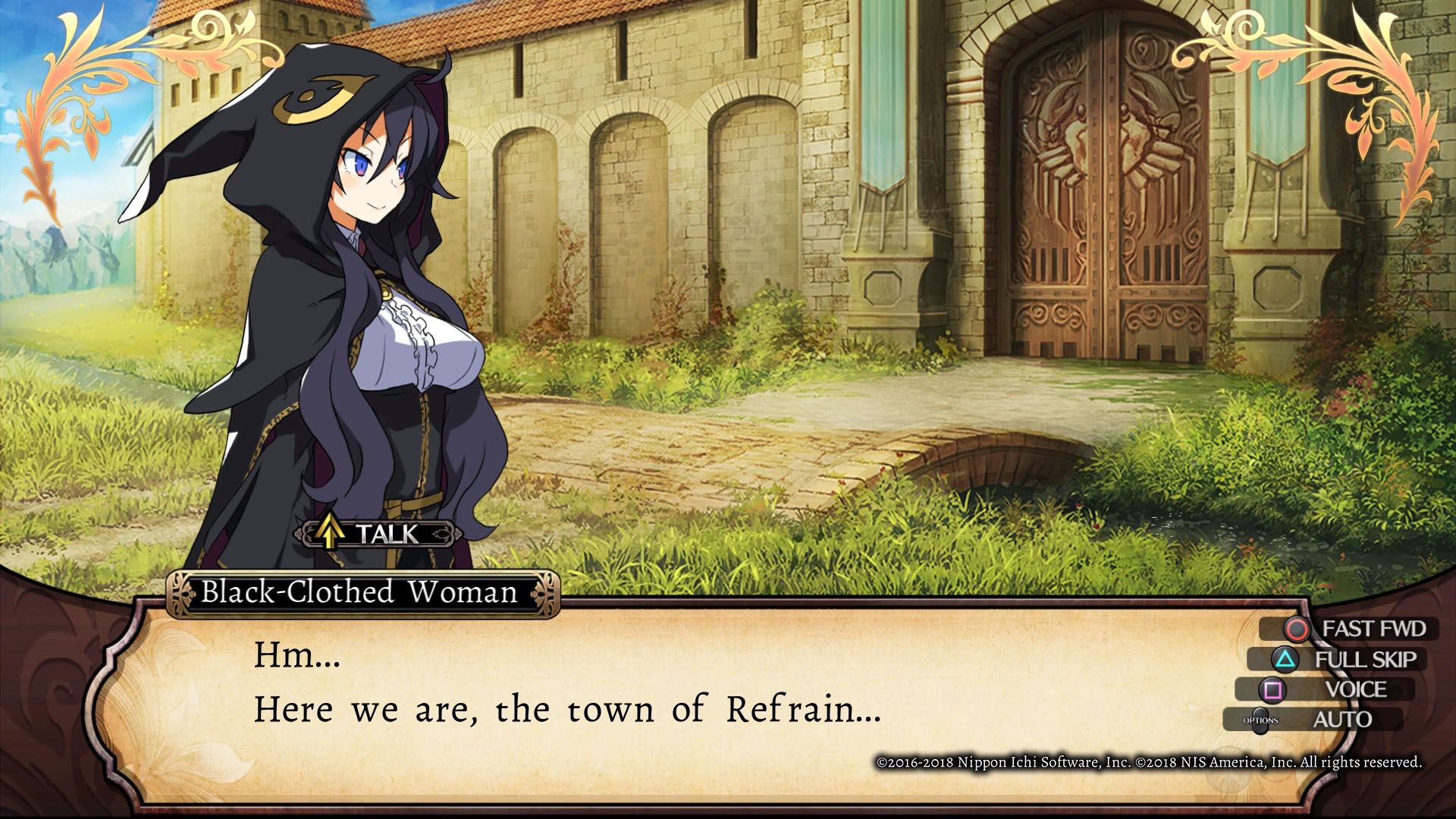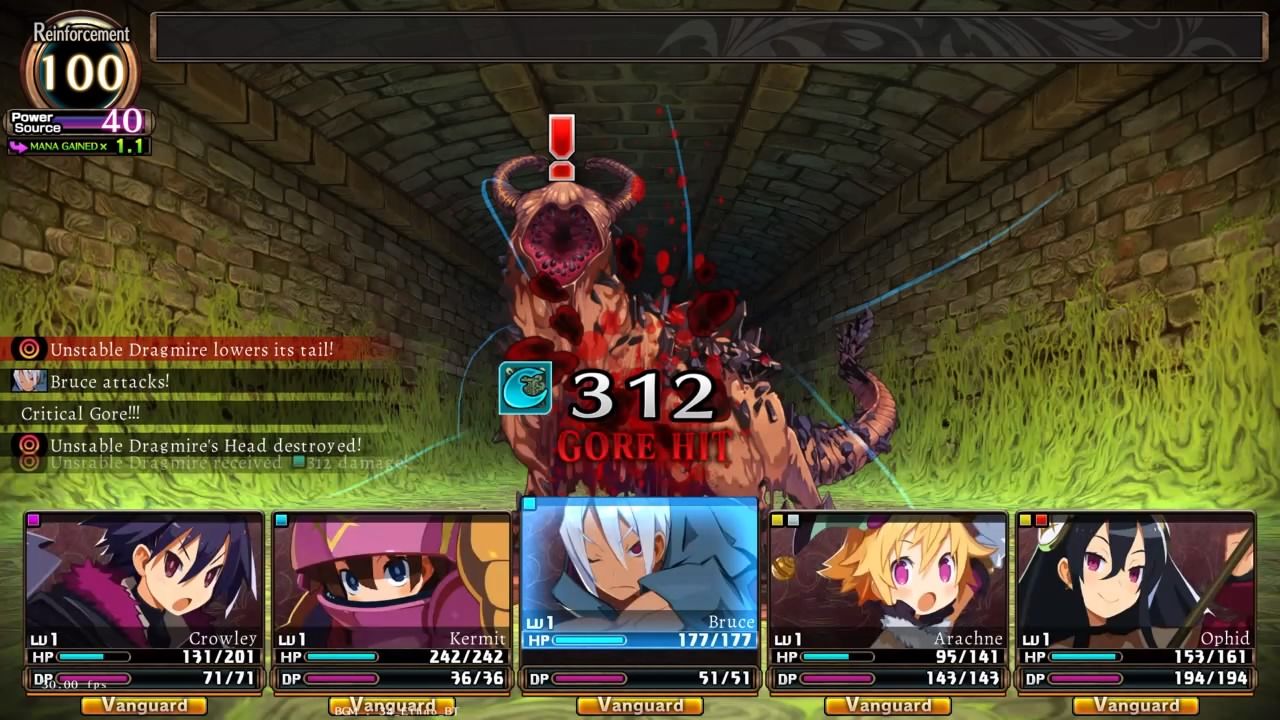A secret announcement at the end of this year's NIS America Press Event, Labyrinth of Refrain: Coven of Dusk came on strong with its initial reveal. For anyone wondering what the fuss is about, Labyrinth of Refrain is actually a relatively straightforward type of game: it's a first-person dungeon crawler. There's a fair bit of introduction in order for the general setup, characters and the mystical, titular Labyrinth. Players actually take on the role of a living book, the Tractatusde Monstrum, enlisted by the Dusk Witch to delve deeper and deeper into the mysterious Labyrinth for the secrets that lay within. The setup is simple: the Dusk Witch Dronya wants only for the player to get to the end of the Labyrinth and everything else -- motivation, rewards or collateral -- is up to the player. Getting a hands-on experience with the game shed some light on just why this dungeon-crawler would be worth any fuss.
Not a flashy game, events play out primarily in a visual novel-style format while the game itself rarely uses 3D models for things that aren't the level. So anyone who has played this sort of first-person, old-school type of dungeon-diving RPG will be right at home with how the core game works. Players advance through corridors, starring one of the four directions at a time, all while looking for ways forward or for treasure. Enemy encounters grow more likely depending on progress, location and it would seem, a bit of RNG. Battles are where, as always, things get complicated. The active party is in formation depending on distance from the front line (Vanguard). Distance, like being in the back of the party, will negatively affect aggro -- itself a character stat called Charm.
The player party is composed of "puppet soldiers" that make up different Covens of combat archetype. Generally speaking, enemies are designed to be fully capable of killing the player's party, so directing aggro is about as important as one would expect. The fights are turn-based and each character's stats play a great deal in determining their turn order, damage output, survival and utility. Characters have general options to attack, defend or use skills and items. The challenge remains important throughout, as without challenge, there is no point in building characters any particular way nor is there any thrill in delving deeper for treasure and progress. Likewise, using skills isn't quite possible outside of combat so when it's a fight, that's when everything's on. A ton of it is familiar too, as players who are accustomed to the idea of units that attract attention (such as tank classes in an MMO) or units that are there for specific utility in a turn-based format (recent examples being Shin Megami Tensei IV and Persona 5) will know the basics of broaching these situations.
The construction of a party is where things get meaty. Each puppet soldier that makes up a playable party is custom made. Players start off with a base class -- things like tanks, rogues, clerics, mages, all-rounders -- then they build off of that. The options are delightfully deep from here, ranging from different stat-growth types to their own flavor text. The amount of control over what puppets are in a party is going to be a beautiful thing to behold for any RPG fan that likes to min-max. How do you mitigate the amount of aggro the squishy support classes will draw in relation to the tougher physical characters at the front? Just what stats are you willing to sacrifice for this DPS class to be the fastest and sharpest she can be? But at the same time, adapting is going to be important. The labyrinth unveils its challenges progressively and with each new challenge, enemy or damage type comes the need to have units that can counter them. Furthermore, the different groupings of each puppet also matter as aligning a physical-minded tank character with support skills that take up a bunch of magic points isn't a great move. Likewise, looking at all the numbers becomes important in planning out even the starting point of a competent team. As with this type of game, progress is ever important and in conjunction to that: endurance. Players will have means of regaining resources needed for giving special orders, switching out units and maintaining their momentum among diminishing combat ability. There is so much to consider and sift through in character creation, party customization and during the dungeon crawling itself.
That said, it's not exactly a streamlined experience, but many people will like it this way. It allows for depth and exploration of its systems, as well as the in-game labyrinth itself. On the other hand, it's very much a specific type of game and anyone who isn't a fan of these old-school turn-based dungeon crawlers won't be a fan of this. There's a hefty amount here and the hands-on time allotted only enough space to scratch the surface. It's hard not to wish the game was a bit more user-friendly, though. Its various systems are nice, as well as all the detailed information available on each character, including the choice to change their stat growths upon level up. The UI could use some cleaning up, like with more dedicated pages for character stats and completely separate ones for equipment -- something it doesn't quite have at the moment -- leading to some initial digging just to find where to equip a new knife. Labyrinth of Refrain will likely still have a niche appeal but that isn't necessarily a bad thing. After all, the satisfying amount of control present once the opening sequence is over lends itself well to newcomers looking to learn what they need to do. This again, seems to only scratch the surface. Needless to say, we'll learn more about just how deep these halls go when Labyrinth of Refrain: Coven of Dusk heads to PlayStation 4, PC and Nintendo Switch this Fall.



